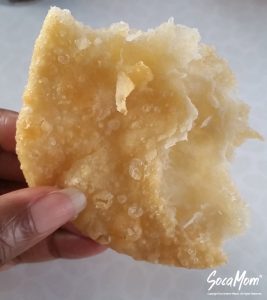 Every new parent expects their newborn babies to have that gorgeous smooth skin that we see in the Gerber and Pampers commercials, but for people of African and/or Asian descent, that expectation doesn’t always become a reality. I was prepared for my child to have certain allergies and reactions – eczema was one of them.
Every new parent expects their newborn babies to have that gorgeous smooth skin that we see in the Gerber and Pampers commercials, but for people of African and/or Asian descent, that expectation doesn’t always become a reality. I was prepared for my child to have certain allergies and reactions – eczema was one of them.
I had eczema – sometimes severe – growing up, and my brother had it something awful. It really became an issue when we were old enough to take care of our own skin and make decisions on what we ate and drank. My mother was a pediatrician for over 20 years, and her specialty was asthma and allergies. There was never a shortage of lotions and steroid creams (that was the main form of treatment back then) in our house. There was a shortage (or total absence) of certain foods, soaps, perfumed lotions, drinks, sodas, candies, sugary cereals, and certain detergents. Her treatment plans for her patients, which was revolutionary at the time, included a mix of dietary changes and a skin care regimen. Some of the things that parents were asked to do to get their kids skin issues under control were controversial for the community she served.
Check out the products I use for myself and the kids here: amazon.com/shop/socamomdc (affiliate link)
Bathing: As Caribbean American and African American people, we believe in bathing daily. I remember having a cousin whose mother bathed her, greased her, and powdered her up to the neck “like a bake ready to fry” EVERY night. According to the treatment plan my mom used for most patients, nightly bathing is a no no. Especially if you are on skin medication as part of your skin care regimen. The scrubbing action and soap irritates the affected area even further, and may remove the medicine before it really gets a chance to start working.
If a parent insisted on bathing the child daily, she suggested a lukewarm “clear” water bath with no soap and gentle wiping of the unaffected areas with a soft cloth. Depending on the age and activity level of the baby/child, she would recommend bathing two to three times per week – or less if possible. If the diaper area was part of the affected area, she would have them to use baby oil and cotton balls to clean the area during wet diaper changes, and wash the area with Dove soap, pat dry, and apply ointment – every time – for bowel movements. Keeping the bottom bacteria free, if that is an affected area, is very important because it is not exposed to light or air, and can get infected easily.
Related: Join Us for a Live Chat about Eczema with IXORA Botanical Beauty
Milk: Caribbean American and African American often times do not respond well to cow’s milk. Research indicates that lactose intolerance and milk protein allergies are more prevalent in people of African, Native American, and Asian descent. Some physicians suggest that children who are prone to these allergies not have cow’s milk at all for the first 12 months of life.
Infant formulas come in several types. Milk based formulas are the least expensive. Soy formula is an option, but can cause equally severe allergic reactions in some people. Breast milk is always best, but is not always an option for mothers and babies. Some babies don’t latch well, mother’s don’t produce enough milk, etc. Also, if the baby has milk allergy, the mother’s diet is restricted if she plans to breastfeed. (One piece of cheese had me in the hospital with my daughter with blood in her stool!)
For older children, you may consider fortified pasteurized goat’s milk, which is usually well tolerated or fortified rice milk. Calcium and fats are important to your child’s development, so don’t forget to look to see that the fat content, Vitamin D, and calcium contents are comparable to cow’s milk. My two sons were on Alimentum and Nutramigen. They smelled awful, but the kids drank it, and their skin stayed clear. These hypoallergenic formulas are used to reduce colic and treat protein allergy. They now come fortified with DHA and ARA as well, and are nutritionally comparable to other mainstream formulas.
Some pediatricians who are unfamiliar with the concerns of African and Asian babies will not recommend changing formula, but will go straight to creams and ointments for treatment. I was blessed to have a Filipino pediatrician for my oldest son (trained by my mom), and an African American pediatrician for my other two children (a classmate of my mom’s), who were sensitive to the needs of African American children. My kids can all tolerate cows milk now, and I think it is because I introduced it to them slowly starting after age 2. If you suspect that your child’s eczema may be triggered by cow’s milk, talk to your pediatrician or allergist about your milk options.
Related: When Bush Tea and Vicks Are Not Enough – Let’s Talk About HealthPlan USA
Citric Acid: Fruit punch, Kool-Aid, soda, orange juice, lemonade, and grapefruit juice were complete no no’s when I was very young, and in the house infrequently, if at all when I was a child/teen. My mom always knew when I had gotten some from a friend’s house or at school, because I would get several spots of eczema in the creases in my elbows and the backs of my knees.
For some reason, citric acid seems to be an irritant that can trigger eczema in some people. It is definitely a trigger in my oldest son – especially orange juice. As my mom explained it – the irritant is the oil in the skin of the orange (people use orange oil as a cleaner!). We think of orange juice as juice squeezed from an orange… not so.
If you think about it, it is not realistic to think that a major manufacturer of orange juice has the time to peel all of the skin from oranges or to cut them and squeeze the juice. If you have ever seen juice squeezed from an orange, it is actually very clear, and mild. Orange juice on a shelf is not at all clear, and is very orange. That is because the whole orange is squeezed – skin and all. Some processors may remove some of the skin first, but not all. During the process, essential oils and solids are removed, but the product is very concentrated, and water is added back into it later. Oils may also be added back to enhance the “orange” flavor. We eat oranges (peeled) but avoid commercially produced orange juice.
Citric acid is used as an additive in a lot of drinks because it is a preservative that also adds a tart taste. Citric acid is also used in cleaners, detergents, soaps, wine production, photography, and explosive production. Some individuals may have severe sensitivity to it that extends beyond eczema. Check with your physician if you believe you or your child may be sensitive to citric acid containing products and foods.
Related: Do So, No Like So: Inspiring My Daughter to Love Her Hair
Harsh or perfumed soap: This was a tough one during my teenage years. We used Dove soap growing up. This was before the influx of hypoallergenic and “dye-free” products. Once the teenage hormones hit, Dove was not always strong enough to keep the odors down on my brother and I. We played several sports, and spent a lot of time outdoors. The combination of being allowed to make our own food choices, sweating during sports, having to use stronger soaps, and having to bathe sometimes twice a day made our skin go out of control a bit.
We used Lever 2000 at the time, which didn’t seem to be to bad, but soaps like Irish Spring would make our skin go crazy. We used plain Vaseline as lotion. When my kids were babies and even now, I use Dove soap or Johnson and Johnson washes to bathe them with Vaseline after bathing. We now use dye and perfume free detergents, but I know some people who do well (and save money) making their own detergent.
There are other triggers that may affect you or your child such as:
- pets
- dust mites
- heat or cold (sweating)
- stress
- pollen
- hormone changes
- other food allergies
- detergents
The remedies outlined here are some of the techniques I used to keep my children’s skin as clear as possible. Every child is different, and some types of eczema or dermatitis cannot be traced to any single cause, source, or irritant.
Here are some other products that worked for us (affiliate links):
- Shea butter
- Avocado oil
- Tea tree oil
- Coconut oil
- Aquaphor
- Dove Body Wash for Sensitive Skin
- All Free and Clear
I am not a physician, and before beginning, altering, or stopping any treatment for eczema or any other ailment, be sure to consult your physician.



